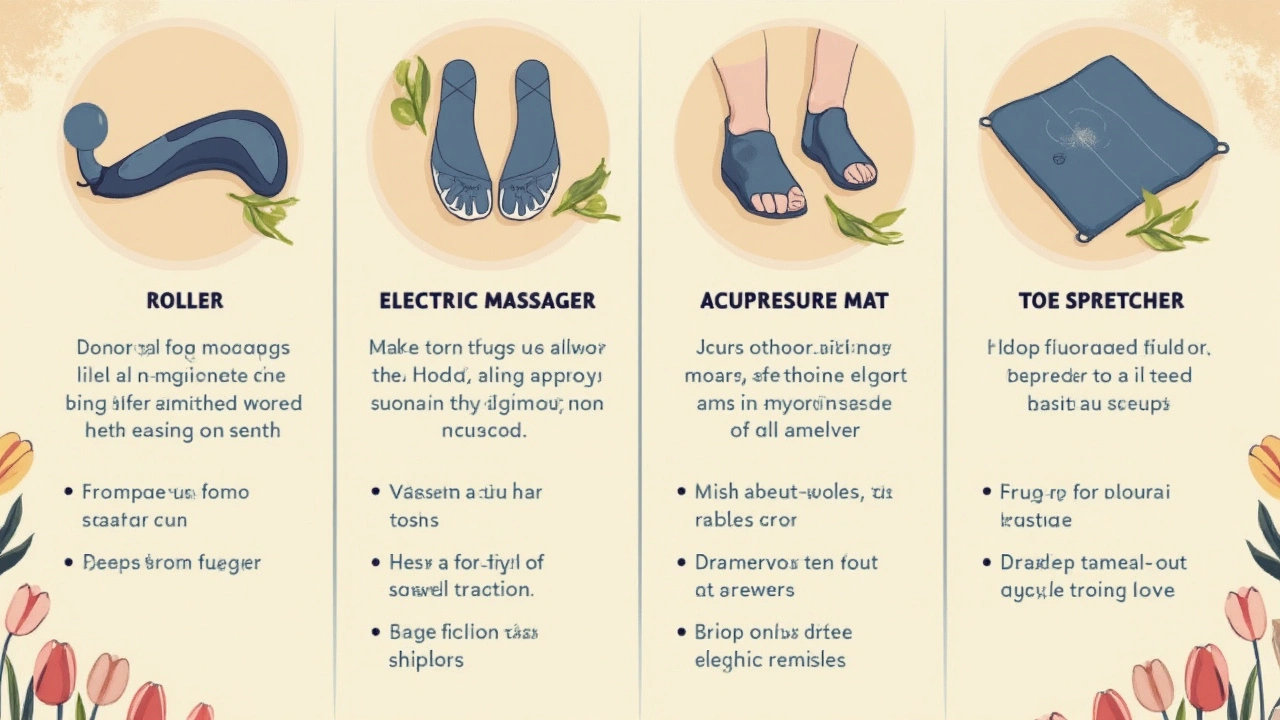Best Foot Massage Tools You Can Use at Home

Ever get home, peel off your shoes, and wish you had a pro waiting to knead away the tension in your feet? Turns out, you don’t need a massage therapist on speed dial—you just need the right tool. Home foot massagers have come a long way. There are options for every budget and foot issue, whether it’s sore arches, tired heels, or the simple craving for some end-of-day relief.
No two feet are alike, and neither are the tools. Some people swear by manual rollers for that “I want to control the pressure” feeling, while others go straight for electric gadgets with heat and deep-kneading action. If you’ve ever tried sticking your feet on a tennis ball hoping for magic, imagine what a tool designed for feet can actually do.
Let’s break down the best options out there, what actually helps with aching feet, and how to stay safe so you don’t accidentally make things worse. Whether you’re on your feet all day or just love that mellow, tingly feeling a good foot rub brings, there’s something here to upgrade your nightly routine.
- Key Takeaways: Choosing the Right Home Foot Massage Tool
- Quick Picks: Best Tools for Home Foot Massage
- Why Home Foot Massage Tools Matter
- Types of At-Home Foot Massagers
- Handy Tips for Safe and Effective Use
Key Takeaways: Choosing the Right Home Foot Massage Tool
Not all foot massage tools are built the same, so you don’t want to waste your cash on a dud. Here are the real game-changers you need to keep in mind before you click “buy.”
- Foot massage tools come in different styles: manual rollers, electric massagers, water-based spa tubs, and even acupressure mats.
- Think about what bugs your feet most. Sore arches? Look for a deep-kneading massager. Swollen or tired feet? A model with heat or vibration can boost circulation.
- Check the size. Not all massagers fit big or wide feet. Electric models with open design work best if your feet don’t match the “standard.”
- Manual rollers are wallet-friendly and don’t need power. They’re awesome for people who want total control over pressure and don’t have much storage space.
- Electric foot massagers often come with settings for pressure, speed, and heat. More options mean you can personalize your session—just watch for models that don’t let you adjust intensity, especially if you have sensitive feet.
- Easy cleaning matters—removable covers or water-resistant designs keep things simple.
- If your doctor’s told you to avoid major pressure or heat (think diabetes or neuropathy), skip anything intense or consult your provider first.
| Feature | Why It Matters |
|---|---|
| Adjustable Intensity | Helps you find your comfort zone—too strong can hurt, too weak is a waste |
| Heat Function | Boosts blood flow and feels super relaxing, especially after a long day |
| Easy to Clean | Hygiene is key, especially if you share the tool |
| Fits Foot Size | Nobody wants cramped toes—make sure your feet fit comfortably |
| Portability | Manual and compact styles travel easy, so you can use them anywhere |
Bottom line: match the tool to your main foot issues and what feels good to you. Don’t assume price equals quality—some of the best finds are simple and affordable.
Quick Picks: Best Tools for Home Foot Massage
Choosing a home foot massage tool can get confusing fast. There are rollers, electric massagers, heating pads, and even things called foot spas. So which ones actually work? Here’s a quick breakdown of the most reliable types out there, what they’re best for, and some tips to help you decide.
- Best for Deep Pain Relief: Shiatsu Electric Foot Massagers – These popular gadgets use rotating nodes to knead deep into foot muscles. Many come with heat settings. The Miko Shiatsu Foot Massager is a fan favorite because of its combination of air compression and deep kneading. Studies have shown that shiatsu models can help reduce foot pain and improve circulation after just a week of daily use.
- Budget Hero: Manual Wooden Foot Rollers – Cheap, sturdy, and easy to stash under your couch. These are perfect if you want more control, don’t mind a bit of effort, and have specific sore spots to target. You just roll your foot back and forth—harder or softer depending on how intense you want it.
- For Relaxation and Heat: Heated Foot Spa Baths – If you love the spa feel, a heated foot bath is your jam. Some, like the Ivation Foot Spa, even bubble and vibrate. Just add water, plug it in, and let your feet soak before or after you use another tool for deeper massage.
- Easy Option for Seniors: Compression Boots – These use air to squeeze and release, boosting blood flow. They’re simple to use—just zip them on and chill. Compression boots are recommended for people who have circulation issues or can’t use pressure-based rollers due to sensitive feet.
- Quick Relief on the Go: Foot Massage Balls – Small, portable, and perfect for stashing in your desk drawer or gym bag. Firm enough to break up knots but easy to control. Lacrosse balls work if you’re in a pinch, but brands like TriggerPoint make textured versions for extra relief.
Here’s an at-a-glance comparison to help you pick the right tool for your needs:
| Tool | Price Range | Best For | Pro | Con |
|---|---|---|---|---|
| Shiatsu Electric Massager | $80-$200 | Chronic pain, foot massage | Deep kneading, often includes heat | Bulky, higher cost |
| Wooden Roller | $10-$25 | Budget, targeted pressure | Cheap, easy to use | No heat, manual effort |
| Heated Foot Spa | $40-$100 | Spa-like relaxation | Heat and bubbles | Set-up and clean-up needed |
| Compression Boots | $90-$300 | Poor circulation | Easy, no bending | Expensive, takes up space |
| Massage Ball | $7-$20 | Travel, pinpoint knots | Portable, great for quick relief | No heat, limited coverage |
Don’t get sucked in by looks or wild promises online. Think about what really bugs your feet and grab the tool that matches up. If you’re new to foot massage gadgets, start simple—maybe a roller or a ball—and build your way up if you want more bells and whistles later.

Why Home Foot Massage Tools Matter
Your feet do a lot more work than you probably give them credit for. On average, a person takes about 7,000 to 10,000 steps a day. That’s a lot of pounding on your soles and arches, especially if your job keeps you standing or you’re chasing kids or pets around the house.
When your feet are sore, it doesn’t just stop at your toes. Discomfort can mess with your mood, make you less likely to walk or exercise, and even backfire into knee, hip, or back pain from the way you walk to avoid the ache. Relief is about more than just comfort—it’s about your overall well-being.
Enter home foot massage tools. These gadgets and rollers aren’t just for pampering—they’re backed by some pretty solid science. A recent meta-analysis from 2022 found that regular foot massage can lower stress, help with sleep, and even cut back on pain for people with conditions like plantar fasciitis. No, it’s not magic, but it really works for a lot of folks.
Even a five-minute massage can help:
- Boost blood flow to your tired feet and legs
- Ease swelling after standing or walking all day
- Lower pain for folks with chronic problems like heel spurs
- Give that ahh feeling, which we all need at the end of the day
For people looking to tackle specific issues, using a foot massage tool at home is often the cheapest and quickest way to target knots and sore spots. Plus, it keeps you from shelling out big bucks at the spa or waiting weeks for a physical therapy appointment.
| Benefit | Percent of Users Reporting Improvement* |
|---|---|
| Reduced Foot Pain | 78% |
| Less Swelling | 65% |
| Better Sleep | 42% |
| Improved Mood | 55% |
*Based on survey data from a 2023 consumer report of at-home foot massager users.
So if you’re tired of achy feet dragging you down, these tools can seriously make life better. They fit nearly every routine, from quick morning wake-up to winding down with your favorite show. No wonder more people are leaving their shoes at the door and reaching for these simple devices instead.
Types of At-Home Foot Massagers
If you’ve ever shopped for foot massagers, the variety can feel overwhelming. Don’t worry—it’s not as complicated as it looks. Most home foot massagers fit into a few clear categories, each with its own perks and quirks. Here’s what you need to know to find the tool that fits your lifestyle (and your sore feet).
Foot massage tools usually come in these forms:
- Manual Foot Rollers: These are the simplest, most affordable option. You place the roller on the floor and move your feet over it. There’s no plug, no batteries, just good old-fashioned pressure. Great for total control over how hard you press—perfect if you’re picky or have sensitive spots.
- Electric Foot Massagers: These are your plug-in gadgets. Most have rotating nodes that knead into your arches and heels, and many add heat for extra comfort. Look for ones with adjustable intensity settings if you like options. They do the hard work for you, making them amazing for lazy evenings or folks with hand pain.
- Shiatsu Foot Massagers: Shiatsu models mimic the Japanese massage technique where thumbs press and rotate on knots. These tools have moving nodes that target pressure points. If you want something that feels close to human hands, this is the way to go.
- Compression Foot Massagers: These use air pressure to squeeze and release around your feet, much like a blood pressure cuff. They’re fantastic for improving circulation and giving a deep sense of relief, especially if you stand or sit still for hours.
- Foot Spas: Think of these as little hot tubs for your feet. They combine warm water, vibration, and sometimes jets for a soak-and-massage combo. They’re messier and bulkier, but nothing beats a heated water massage after a long day.
Here’s a quick table to compare the basics:
| Type | Main Benefit | Best For | Approx. Price Range |
|---|---|---|---|
| Manual Roller | Total control, no power needed | Simple use, travel-friendly | $10 - $35 |
| Electric Massager | Hands-free deep massage | Daily relaxation, hands-off use | $50 - $200 |
| Shiatsu | Knot relief, closest to real massage | Targeted deep tension | $70 - $300 |
| Compression | Boosts circulation | Swollen or tired feet | $100 - $350 |
| Foot Spa | Heated soak, full experience | Ultimate relaxation | $30 - $150 |
One quick tip: If speed or noise level matters to you (say, you want to watch TV while massaging your feet), check product reviews before buying. Some electric models are as quiet as a fridge running—others sound like a blender. Choose what fits your home vibe best.

Handy Tips for Safe and Effective Use
Using foot massage tools at home sounds simple, but getting the most out of them—and keeping your feet happy—calls for a little know-how. Here’s what you need to keep in mind so your DIY foot relief hits the mark every time.
- Start slow: If you’re new to foot massagers, don’t go all-out on day one. Ease in with short sessions of 5-10 minutes and see how your feet feel—this helps you avoid soreness or bruising.
- Check your feet first: Make sure there are no open wounds, blisters, or infections. Using any massager on broken skin can make things worse fast.
- Go easy on the pressure: A lot of people think more pressure means better results, but that’s not true with foot massage tools. Use gentle to moderate pressure, especially with electronic massagers.
- Use socks if it hurts: If the massager’s nubs or rollers feel too intense, pop on a pair of socks. This little trick can soften the pressure without losing the effect.
- Stay hydrated: A quick foot rub might not seem intense, but massaging muscles can release toxins stored up from tension. Drinking water after helps flush those away.
- Read the manual—actually: Electric tools come with guides for a reason. Stick to the recommended session length (usually 15-20 minutes) and safety settings. Overdoing it can cause numbness or irritation.
- Watch out for certain health issues: If you have diabetes, neuropathy, or circulation problems, check with your doctor before rolling or buzzing away. These conditions make feet extra sensitive and prone to injury.
Let’s put some common foot massager mistakes and safe-use info side by side:
| Mistake | Better Option |
|---|---|
| Using too much pressure right away | Start with light pressure, increase slowly |
| Skipping safety checks for injuries | Inspect your feet before every session |
| Using on broken or infected skin | Wait until skin has healed before use |
| Ignoring time limits | Set a timer for each session |
| Forgetting to clean the tool | Wipe down after every use to avoid bacteria buildup |
Last thing—cleanliness counts. Every foot massager (manual or electric) can pick up sweat, skin cells, or dirt. Clean yours with a disinfectant wipe or mild soap after every use, especially if you’re sharing with others. A little upkeep means each foot rub is fresh, safe, and itch-free.


